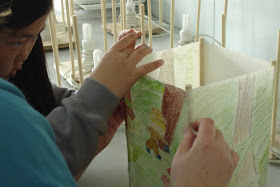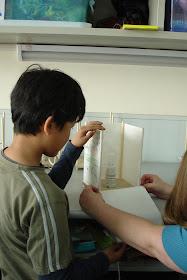My little sister is in his class this year. (We're ten years apart.) He's still up to his old reading tricks, and gave the same "I can teach anything" speech. My mom told me on Skype one day that it's the same for me. It's true! We can make art about ANYTHING! So how do I pick subject matter? I try to make it relevant to their lives, and often tie it to their classroom curriculum.
This takes a lot of planning. Unfortunately, it also takes effort on the part of the classroom teachers. If they don't talk to me about their units, I can't make connections. This year, I've sent a few e-mail pleas to the teachers---please tell me! I know it takes a few minutes of their time, but the reinforcement the students get in my class is DEFINITELY worth the effort!
One of those e-mails resulted in this project!
Fourth grade has a unit on electricity. Their teacher asked me "would you want to work with me to make lamps?"
YES!
 I cannot claim to have taken any classes with Lyn Godley, but I did teach her son during my first student teaching placement. She came in and gave a presentation to the class about her lighting designs and the work of various KU students. The juniors then started a hanging light project, using IKEA pre-fab cords and making their own lampshades.
I cannot claim to have taken any classes with Lyn Godley, but I did teach her son during my first student teaching placement. She came in and gave a presentation to the class about her lighting designs and the work of various KU students. The juniors then started a hanging light project, using IKEA pre-fab cords and making their own lampshades.After a little brainstorming about the possibilities at our school with our students, Mrs. Early and I decided on a design. The fourth graders would discuss design and lighting in my class. Mr. Early (her husband and our facilities manager) would have his staff create wooden bases. The kids would wire the lamps in Mrs. Early's class. In my class, we'd make the paper shades and glue them to the wooden structure.
To introduce the art component, we discussed the difference between decoration and function. I pulled together a slide show of various lighting projects (compliments of Miss Emily and Miss Amanda: those are some beautiful lights you've made!). I even showed the movarian bell lights made by Miss Emily's elementary students during student teaching! When I got to Godley's crinkle lamp, I jumped over to a video on youtube about the lighting design by Godley and KU students for the outside of the Goggleworks. We ended the discussion by looking at various paper lanterns, including some rectangular lamps from
IKEA that looked quite similar to our basic design.
In the remaining classtime and the following week, the students created three possible designs for the lampshade. Our little mock-ups were quite simple---a half sheet of A4 copy paper (hotdog style) folded into four sections.
 After all the designs were finished, we taped the open side together. Each student put their designs above three columns on another sheet of copy paper. The two rows were + compliments and - suggestions or concerns. I asked the students to think of at least one + and one - for each design.
After all the designs were finished, we taped the open side together. Each student put their designs above three columns on another sheet of copy paper. The two rows were + compliments and - suggestions or concerns. I asked the students to think of at least one + and one - for each design.Before the students read their sheets, I reminded them that these were not intended to hurt feelings. They should read all the ideas, think about them, but remember, they are just someone's opinion. They make the decision about which design should be implemented. (I didn't say implemented, but sometimes I miss using big words!)

If I'd been more careful in my planning, I would have designed the lamp size to correspond with the paper. Instead, I arbitrarily picked a size for the base. It was loosely based on the scrap of A4 paper I was sketching on and took into consideration the distance between the lightbulb and the paper. Unfortunately, when all was said and done, the long side of the paper was 1 or 2 cms too short to wrap around all four sides! Though it was frustrating, we made do by making three sides connected and a fourth separate panel.
Craftsmanship was very important in this project. I didn't have lots of extra paper for the shade. I told them the time to experiment was over. They made three designs already. Pick the best and make it carefully and neatly!
No starting again!

I also emphasized that this was THEIR light, for THEIR room. If they did a horrible job, it wasn't just their grade that would be affected. They wouldn't have an awesome project in their room, something in which they could take pride!
After the first day of coloring, we did a few tests. The shades looked best when the pencil side was facing out. Also, soft colored pencil was washed out by the compact fluorescent bulb.
As students finished, I worked one-on-one with them to glue the paper shades to the wooden dowels. The finished lamps looked fabulous!
While they wanted to take them home right away, there were a few things to happen first. One of Mr. Early's staff is an electrician by trade. He checked over their wiring before the projects made it to the artroom. He did a second check after the shades were finished. Also, Mrs. Early and I wanted the lamps to be in her classroom for Parent/Teacher conferences.
After a few days, the students finally got to take the lamps home. You should have seen the smiles as the students carried their projects to the bus that afternoon!




